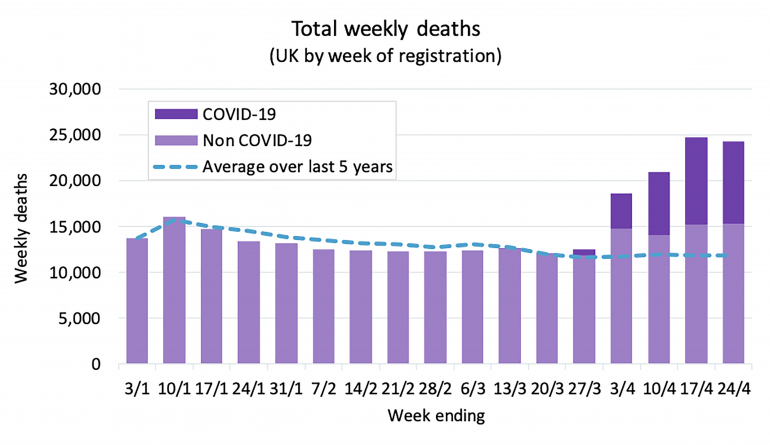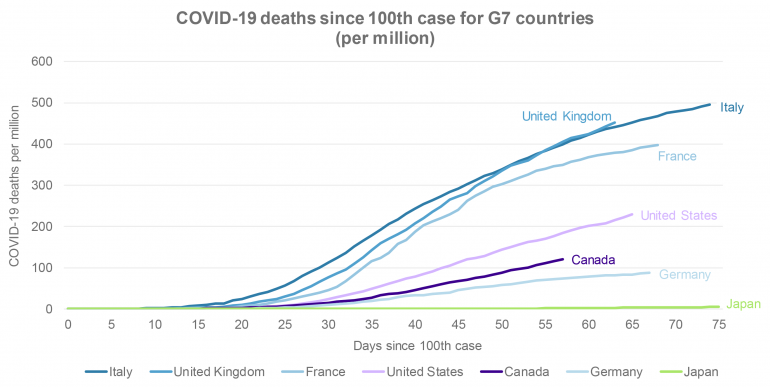Over the past two weeks Club Vita UK has put out a number of blogs detailing the devastating impact COVID-19 has had in the United Kingdom, resulting in a significant increase in UK deaths at an overall population level. The fact that detailed data regarding all UK deaths is available weekly (i.e., not just those due to COVID-19) has allowed a much better understanding of the severity of the pandemic in the UK, including the identification of COVID-19 deaths not captured in the official numbers. The chart below is taken from the Club Vita UK’s latest blog and not only highlights the significant increase in overall deaths directly due to COVID-19 but also a substantial rise in other deaths, likely due to indirect effects of COVID-19 (e.g., due to healthcare capacity and people putting off seeking medical attention). This analysis provides valuable information when it comes to deciding when to ease the measures currently in place in the UK in response to the pandemic – unfortunately similar information just isn’t available in Canada at this point (at least not publicly).

Source: Club Vita analysis of UK Office of National Statistics data available as at May 5, 2020.
While there are daily updates regarding COVID-19 cases and deaths in Canada, there is a near total lack of up-to-date data regarding overall Canadian population deaths. To my knowledge, there is no publicly available data regarding weekly Canadian population deaths, with the closest substitute being monthly deaths only up until 2018 for most provinces – British Columbia (BC) is the notable exception, reporting current 2020 monthly deaths, and Quebec reports preliminary monthly deaths but currently only to February 2020. The mortality data available in Canada is therefore a far cry from the detailed and up-to-date data available in the UK, making it quite difficult to confidently comment on the impact COVID-19 has had on overall Canadian mortality to date.
The following material investigates the potential impact COVID-19 has had to date on overall Canadian mortality in the absence of up-to-date Canadian mortality data. A key finding is that COVID-19 has very likely increased overall mortality for Quebec, particularly in Montreal, however without up-to-date province-level overall mortality data it is difficult to estimate the magnitude of the increase. Ontario mortality has also likely been elevated due to COVID-19, but to a lesser extent than Quebec. The mortality impact of COVID-19 for the remainder of Canada appears to be relatively modest (this is supported for BC based on the latest BC monthly data available). However, these comments depend on the reported COVID-19 deaths being fully captured and there not being a material increase in non-COVID-19 deaths.
Impact in Canada compared to other countries
If we look purely at the number of COVID-19 deaths reported in Canada compared to that for other major developed countries, it appears that Canada’s experience with COVID-19 has not been as severe as many of our European peers and the US. This is illustrated by the chart below which shows the number of COVID-19 deaths (per million for each country to account for differences in population size) for G7 countries from the day since the 100th confirmed case for each country.

Source: Club Vita analysis of data from the COVID-19 Data Repository by the Center for Systems Science and Engineering at Johns Hopkins University as of May 7, 2020 and 2020 population estimates from the United Nations World Population Prospects 2019.
If we look at the number of Canadian COVID-19 deaths by province, we see that Quebec has by far been the hardest hit. The following chart shows COVID-19 deaths per million by province, as well as for Montreal and Toronto, as of May 7, 2020.

Source: Results for Canada and each province are based on COVID-19 Canada Open Data Working Group data as of May 7, 2020 divided by the respective Statistics Canada Q1 2020 population estimates (in millions). Results for Montreal and Toronto are based on COVID-19 data for the Montreal health region and the City of Toronto as of May 7, 2020 divided by 2018 population estimates (in millions) for the Montreal health region and the City of Toronto projected to Q1 2020 based on provincial population growth.
We see that the results for Quebec are almost three times that for Ontario (which is the next worst affected province). The overall COVID-19 case fatality rate (i.e., the number of COVID-19 deaths divided by the number of cases) is currently fairly similar for Quebec and Ontario (7.5% and 7.9% respectively), so the higher number of deaths in Quebec appears to be due to greater spread of the virus. It is worth noting that the amount of testing per capita has been higher in Quebec than in Ontario, which could mean that Ontario has more unreported (i.e., missed) COVID-19 deaths compared to Quebec. For both Quebec and Ontario, the majority of deaths have been among those living in long-term care facilities and seniors’ residences. Montreal is the clear epicentre of the pandemic in Quebec and accounts for over 60% of Quebec’s COVID-19 deaths to date, with Montreal deaths per million being approximately 2.5 times that for all of Quebec. In contrast, COVID-19 deaths (per million) for Toronto are only about 1.5 times higher than that for all of Ontario.
There are different theories regarding why Quebec has been hit so hard. One likely contributing factor was that Quebec’s spring break occurs earlier than much of Canada. Many Quebecers were travelling the first week of March when COVID-19 was spreading between travelers but had not fully escalated in Canada. Vacationers returning to Quebec were going about their normal life as self-isolation measures for travelers returning to Canada only came into effect March 12th. Another key factor is the large proportion of Quebec seniors living in seniors’ residences and long-term care facilities, which is among the highest of all provinces. Additionally, Quebec has had higher mortality due to other respiratory illnesses (i.e., influenza and pneumonia) in recent years, as highlighted by the following chart.

Source: Club Vita analysis based on Statistics Canada data for leading causes of death and population estimates by province.
While the proportion of annual deaths due to influenza and pneumonia are relatively small, they largely occur during winter months and like COVID-19, hit seniors the hardest. In fact, the higher number of Quebec deaths due to influenza and pneumonia is likely a key contributing factor to the much higher level of excess winter deaths in Quebec compared to other Canadian provinces, as outlined in a Club Vita article late last year. The table below attempts to put the COVID-19 deaths across Canada (based on provinces with 10 or more COVID-19 deaths) in context by comparing to 2018 deaths due to influenza and pneumonia. While there are more deaths due to pneumonia than influenza, pneumonia can be caused by the flu. The number of deaths attributed to influenza has been much more volatile from year-to-year than those from pneumonia, with 2018 being a particularly deadly year for the flu.

Source: COVID-19 Canada Open Data Working Group data as of May 7, 2020 and Statistics Canada data for leading causes of death by province.
Better data leads to better decisions
While the analysis presented here provides a sense of the impact COVID-19 has had on Canadian mortality to date, a much better assessment would be possible with robust up-to-date data (e.g., weekly death data similar to the UK). I truly hope that provincial governments have access to detailed up-to-date mortality data not available to the public to fully inform their decisions during this crisis, but fear this may not be the case. I am optimistic that there will be many changes that are implemented in Canada following the COVID-19 crisis that help better protect the most vulnerable against epidemics/pandemics in the future, including much timelier and more comprehensive data.




